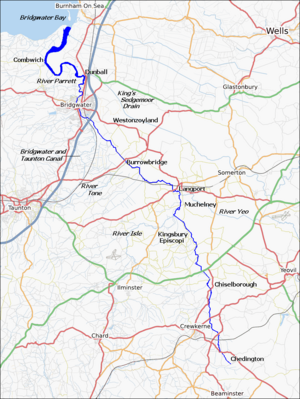River Parrett facts for kids
The River Parrett is a big river in Somerset and Dorset, England. It begins in a county called Dorset, near a place called Chedington. From there, it flows mostly northwest through the Somerset Levels. It passes by Bridgewater before emptying into the Bristol Channel near Burnham-on-Sea. The area where the river meets the sea is a special nature spot called Bridgewater Bay National Nature Reserve.
The River Parrett is about 37 miles (60 kilometers) long. Many smaller rivers, called tributaries, flow into it. These include the Rivers Tone, Isle, and Yeo. Another river, the River Cary, joins the Parrett through a special channel called the King's Sedgemoor Drain. The River Parrett and its tributaries drain a huge area, covering about half of Somerset's land.
Contents
The River Parrett's Journey
The River Parrett has an interesting path from its start to the sea.
From Hills to Flatlands
The river begins its journey in the hills of Dorset. It then flows downhill and enters the Somerset Levels. This area is very flat and low-lying. Because the land is so flat, the river flows very slowly here. This slow flow means the river can often overflow its banks, especially during heavy rain or high tides.
Tidal Waters
For about 18.6 miles (30 kilometers) upstream, the River Parrett is "tidal." This means its water level goes up and down with the ocean's tides, just like the sea itself. This tidal part of the river reaches as far inland as a small village called Oath.
Reaching the Bristol Channel
Finally, the River Parrett flows into the Bristol Channel. This is a large body of water that separates South Wales from Southwest England. The mouth of the river, where it meets the sea, is a protected area known as Bridgewater Bay National Nature Reserve. This reserve is important for many types of wildlife.
Why the River Parrett is Important
The River Parrett plays a big role in the area it flows through.
Managing Water
The river is very important for draining water from the Somerset Levels. This area is naturally wet and marshy. Over hundreds of years, people have built drains, canals, and pumping stations to help manage the water. This allows the land to be used for farming and prevents homes from flooding too often. Places like the Westonzoyland Pumping Station Museum show how people have worked to control the river's flow.
Wildlife and Nature
The River Parrett and its surrounding areas are home to lots of different plants and animals. The mudflats and salt marshes near the river's mouth are especially important for birds. Many birds stop here during their long migrations. The Bridgewater Bay National Nature Reserve helps protect these special habitats.
History and Transport
For a long time, the River Parrett was used for transport. Boats would carry goods up and down the river, connecting towns like Bridgwater to the sea. Bridges like Bridgwater Town Bridge and Great Bow Bridge at Langport were built to cross the river. Even today, you can see old wharves and ironworks along its banks, reminding us of its past importance for trade.
Dealing with Floods
Because the River Parrett flows through very flat land and is tidal, it can flood often. This happens especially in winter when there's a lot of rain, or when very high tides push water up the river.
People have built special structures, like sluices (called "clyces" locally), to help control the water. For example, Monk's Leaze clyce helps manage water between the River Parrett and a relief channel called the Sowy River. These efforts help protect homes and farms from being completely covered by water.
Images for kids
-
Aerial view of the mouth of the River Parrett as it flows into Bridgwater Bay
-
The river near Pawlett showing Hinkley Point power stations A and B
-
The river near the A303 at South Petherton
-
The flooded Southlake Moor in the winter of 1985
-
Dunball Wharf. To the right is Dunball clyce where the King's Sedgemoor Drain flows into the River Parrett.
-
Great Bow Bridge at Langport
-
Monk's Leaze clyce. This sluice regulates the flow of water between the River Parrett and the Sowy River (the River Parrett Relief Channel).
-
View from the summit of Burrow Mump across the winter-flooded Somerset levels toward Aller Hill and the village of Aller, Somerset.
-
Tidal mudflats at Combwich, near the mouth of the River Parrett on Bridgwater Bay

















